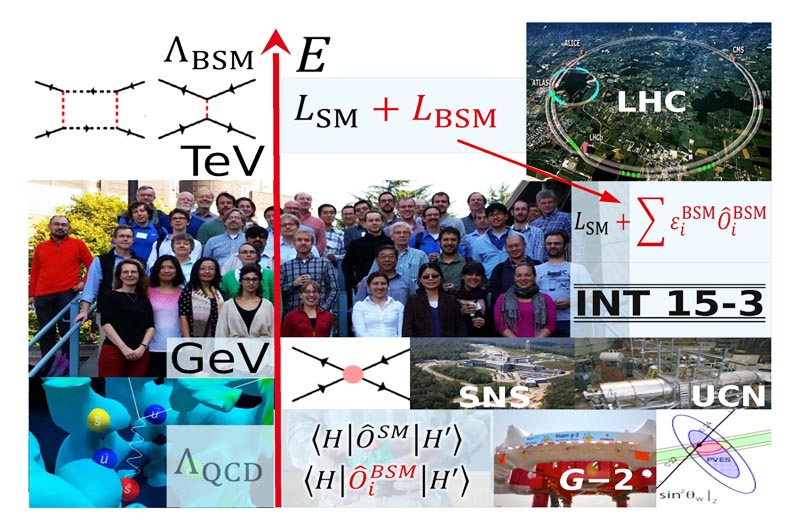 |

The
INT
program
Intersections
of
BSM
Phenomenology
and
QCD
for
New
Physics
Searches
was
held
in
Seattle,
Washington
from
Sept.
14-Oct.
23,
2015.
The
program
was
organized
by
Huey-Wen
Lin
(University
of
California,
Berkeley),
Susan
Gardner
(University
of
Kentucky),
Felipe
J.
Llanes-Estrada
(Universidad
Complutense
de
Madrid),
and
Ruth
Van
de
Water
(Fermi
National
Accelerator
Laboratory).
The
main
purpose
of
the
six-week
program
was
to
bring
together
theorists
from
the
nuclear-
and
particle-physics
communities
to
address
key
issues
in
the
assessment
of
the
QCD
inputs
needed
to
realize
the
next
generation
of
low-energy
precision
experiments,
with
the
end
of
identifying
possible
physics
beyond
the
Standard
Model.
Such
new-physics
searches
span
a
range
of
physics
subfields,
and
we
organized
our
program
into
themes
that
would
collect
them.
Within
these
themes,
we
discussed
ways
in
which
lattice
QCD,
as
well
as
other
non-
perturbative
approaches,
such
as
those
employing
ancillary
experimental
data
and
symmetries,
could
be
used
to
sharpen
windows
on
new
physics
from
the
existing
and
expected
experimental
results.
Our program included
-
Searches
for
non-V-A
interactions
in
weak
decays
and
computations
of
nucleon
charges
pertinent
to
such
searches
-
Searches
for
CP
and
T
violation
in
light-quark
systems,
including
searches
for
permanent
electric
dipole
moments
and
QCD
calculations
of
the
needed
hadronic
matrix
elements,
as
well
as
for
T-odd
decay
correlations
-
Searches
for
baryon
number
violation,
including
neutron-antineutron
oscillations
and
computations
of
related
hadronic
matrix
elements
-
Investigations
of
dark-matter
models
and
cosmologies
with
lattice
QCD,
as
well
as
of
WIMP-nucleon
interactions
within
QCD
-
Searches
for
modifications
of
gravity
and
of
fundamental
constants
accessible
to
nuclear
physics
-
Investigations
of
hadronic
contributions
to
g-2
of
the
muon
and
to
the
proton-
radius
puzzle
-
Searches
for
violations
of
lepton-flavor
universality
via
light-hadron
decays
-
Nuclear
and
hadronic
matrix
elements
for
the
accelerator-based
neutrino-physics
program
-
Determinations
of
flavor-separated
PDFs,
as
well
as
PDFs
at
large
x
and
with
applications
to
the
LHC
-
Lattice
QCD
computations
of
PDFs
and
connections
to
global
PDF
fits
The
program
included
a
five-day
workshop
"QCD
for
New
Physics
at
the
Precision
Frontier"
during
the
third
week
of
the
program,
Sept.
28-Oct.
2.
During
the
workshop
week,
it
turned
out
that
10
presentations
were
given
by
female
speakers
(out
of
a
total
of
40),
and
5
of
those
were
review
talks.
During
the
last
2
days
of
week
2,
we
also
held
a
mini-workshop
on
baryon
number
violation,
with
an
emphasis
on
neutron-antineutron
oscillations,
providing
a
venue
for
experts
to
discuss
recent
work
in
depth.
During
this
program,
we
live-streamed
a
majority
of
the
presentations
through
Adobe
Connect
and
recorded
podcasts
for
future
viewing
(if
approved
by
the
speaker).
About
70
talks
are
now
available
from
the
program
website,
under
the
link
"Talks
online".
We
think
the
recordings
will
be
very
valuable
for
students
and
postdocs
who
want
to
do
work
in
this
direction
and
anticipate
that,
over
the
next
few
years,
many
more
people
will
benefit
from
our
investment.
Several
important
new
results
were
highlighted
by
and
discussed
in
our
program.
These
include
computational
advances
in
lattice
QCD,
for
example,
the
remarkable
new
progress
of
the
RBC
Collaboration
in
their
evaluation
of
the
hadronic
light-by-light
(HLbL)
contribution
to
the
anomalous
magnetic
moment
of
the
muon
(with
5%
statistical
error
at
a
near-physical
pion
mass).
Even
though
there
are
systematic
effects
to
be
improved,
the
collaboration
is
on
track
to
provide
lattice-QCD
input
on
the
HLbL
contribution
needed
for
the
interpretation
of
an
improved
experimental
measurement.
Another
example
is
the
detailed
systematics
and
high-statistics
(up
to
65,000
measurements)
study
by
the
PNDME
Collaboration,
revealing
that
statistical
fluctuations
and
unaccounted
systematics
are
likely
culprits
in
the
puzzling
inability
of
recent
lattice-QCD
calculations
to
reproduce
the
value
of
the
nucleon
axial
charge
measured
in
beta
decay.
Foundational
advances
in
the
application
of
effective
field
theory
to
the
analysis
of
new-physics
observables,
such
as
the
dark-matter
(WIMP)-nucleon
cross
section,
as
well
as
of
the
permanent
electric
dipole
moments
of
the
neutron,
nuclei,
and
atoms,
that
sharpen
the
connection
of
experimental
searches
to
high-
energy
sources
of
new
physics
were
also
reported.
However,
a
number
of
problems
remain,
even
after
a
few
years
of
theoretical
effort.
For
example,
the
mismatch
between
the
proton
radius
extracted
from
the
muonic
hydrogen
Lamb
shift
and
from
ordinary
hydrogen
spectroscopy
(or
electron-proton
scattering
data)
has
not
been
resolved.
In
addition,
the
flavored
parton-distribution
functions
(PDFs)
in
the
proton,
such
as
the
strange
and
anti-strange
PDFs,
remain
poorly
known
even
after
recent
global
PDF
analyses.
One
may
look
forward
to
future
experiments
or
precision
lattice
QCD
inputs
to
help
resolve
these
issues.
We
expect
several
new
collaborations
to
emerge
as
a
result
of
our
program,
as
well
as
a
number
of
publications
in
the
near
future
resulting
from
discussion
and
interactions
during
the
program.
The
subject
is
very
active,
with
the
expectation
of
new
discoveries
in
years
to
come.
|


